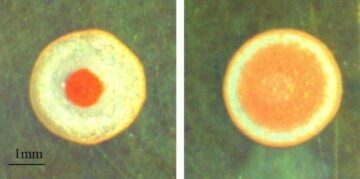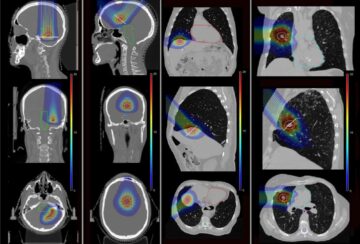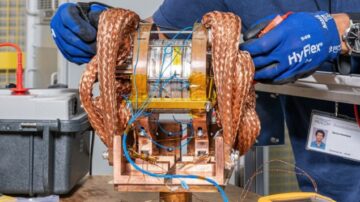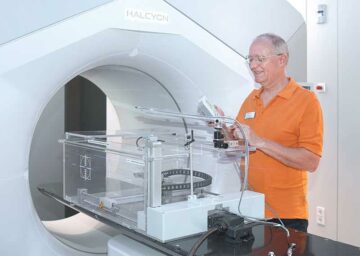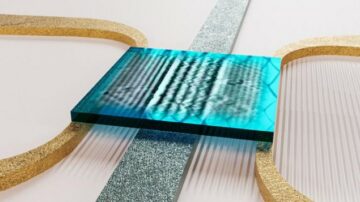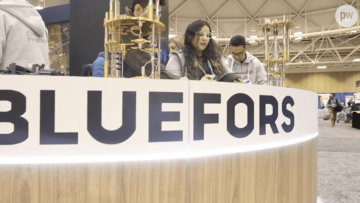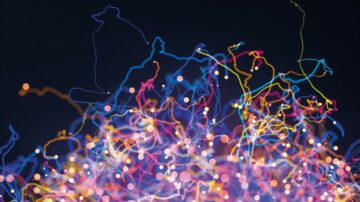The German research powerhouse DESY made its name in high-energy physics, but the Center for Quantum Technology and Applications (CQTA) aims to extend – and amplify – the lab’s efforts in quantum science. Head of CQTA Karl Jansen talks to Joe McEntee about the importance of R&D partnerships in the centre’s long-term business model
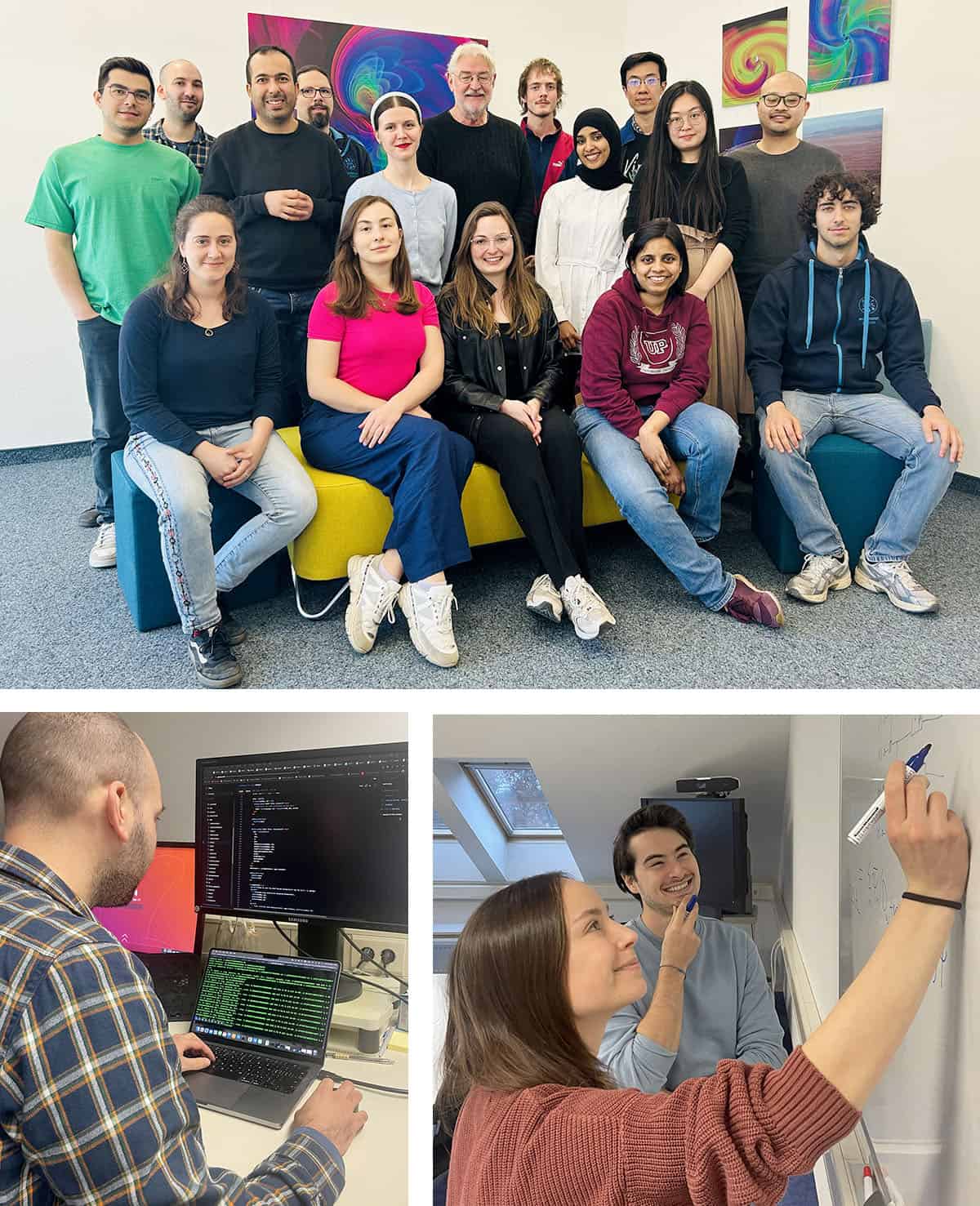
As a German national laboratory rooted in physics, and one of the world’s leading accelerator research centres, DESY’s scientific endeavours fall under four main themes: particle physics, photon science, astroparticle physics and accelerator physics. Those complementary research pathways, pursued with a network of national and international partners, mean that DESY attracts more than 3000 guest scientists from over 40 countries every year. The laboratory is also a coveted R&D hub for industry, its leading-edge experimental facilities offering a unique addition to the innovation pipeline of Europe’s small and medium-sized enterprises as well as established technology companies.
The CQTA team is here to help industry, academic and government partners to formulate their problems in such a way that they can run on a quantum computer
That outward-facing working model underpins a nascent R&D endeavour seeking to build on DESY’s capabilities in quantum science and technology. The goal: to support the lab’s diverse high-energy physics programme, while at the same time enabling all sorts of downstream impacts in industrial and commercial applications. Those efforts are channelled through the Center for Quantum Technology and Applications (CQTA), established at DESY’s Zeuthen campus on the outskirts of Berlin with €15m of seed funding from the state of Brandenburg.
A quantum QUEST in Cyprus
Earlier this year, Karl Jansen, head of DESY’s CQTA, was awarded a €2.5m Academic Chair from the European Research Executive Agency (REA), a pan-European funding body for research and innovation. Jansen, DESY’s first REA Chair, will use the funding to establish a new research centre for quantum computing at the Cyprus Institute.
The QUantum Computing for Excellence in Science and Technology (QUEST) laboratory, located on the outskirts of Nicosia, will be fully connected with the CQTA research programme at DESY in Zeuthen. The joint goal: to improve research capacity in Cyprus by creating a regional centre-of-excellence for quantum computing R&D, in turn attracting high-level quantum scientists and engineers to the Eastern Mediterranean.
“As the REA Chair for QUEST,” says Jansen, “I am working with colleagues at the Cyprus Institute to establish a quantum group consisting of an associate professor as well as several postdocs and PhD students. Another QUEST priority is to provide hands-on training for students interested in pursuing a research career in quantum science and engineering.”
Launched in January 2022, CQTA seeks to exploit DESY’s basic science programmes in quantum computing, quantum materials and quantum sensing. “DESY has put in place a quantum technologies taskforce to coordinate its quantum R&D effort, with CQTA providing a focal point for operational implementation of quantum computing and quantum sensing,” says Karl Jansen, head of CQTA and a professor of physics at DESY. “Our portfolio of activity at CQTA is broadening all the time and what we hope for as an outcome is to identify use-cases where we can clearly deliver ‘quantum advantage’ through quantum computing methods.”
Quantum advantage in science
In terms of operational priorities, CQTA’s remit runs along several main tracks: developing quantum algorithms and methods; facilitating access to quantum computing hardware for DESY’s research and industry partners; benchmarking, testing and verification of quantum hardware; and running a quantum metrology programme using trapped-ion clocks to search for “new physics” beyond the Standard Model. There’s also a custom training programme in the works to cater for beginners looking to grasp the basics of quantum computing, as well as targeting advanced practitioners in research and industry.

Fermilab’s SQMS Center addresses all aspects of the ‘quantum puzzle’
Progress is encouraging, with flagship CQTA projects already underway in support of DESY’s core physics programmes. The Laser Und XFEL Experiment (LUXE), for example, is a research collaboration between DESY scientists and their counterparts at the European X-ray Free Electron Laser (Eu.XFEL) in Hamburg to study quantum electrodynamics (QED) processes at the so-called “strong field frontier” (essentially probing the interactions of a high-intensity optical laser and the 16.5 GeV electron beam of the Eu.XFEL).
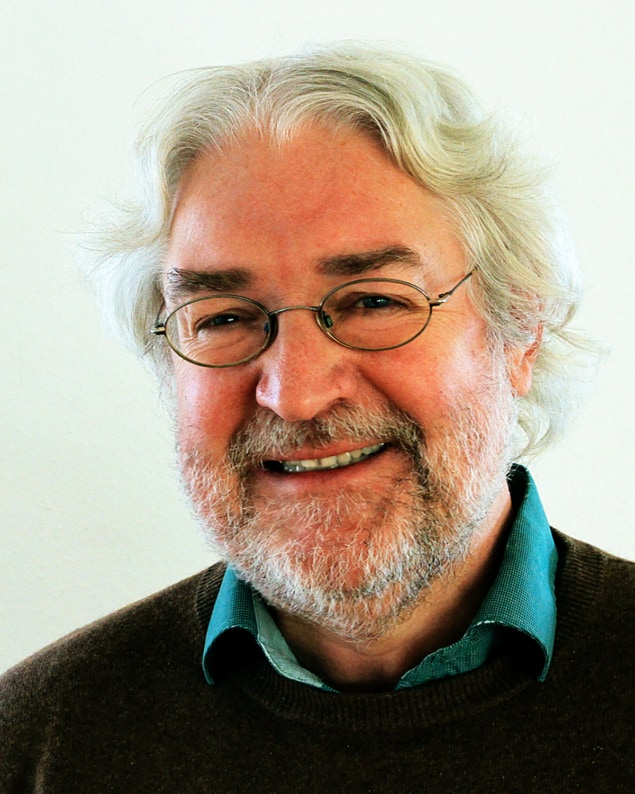
CQTA researchers, for their part, are conducting proof-of-principle studies within LUXE, deploying quantum hardware to investigate the use of gate-based quantum computers for pattern recognition in particle-track reconstruction. The hope is that quantum algorithms and methods developed within LUXE will be transferable to experiments at other high-energy physics facilities, helping scientists to process enormous amounts of data in a more efficient way.
Another active area of investigation is the impact of noise in quantum algorithms. “Today’s quantum computers are very noisy,” says Jansen, “but that noise can be helpful if an algorithm becomes ‘stuck’ in a corner of parameter space.” Adding some noise, in other words, can drive an algorithm away from a wrong result towards the searched-for solution (although too much noise will mean no solution is found at all). “What we’re looking for in each case is the ‘sweet-spot’ and the optimal amount of noise,” Jansen adds.
Quantum advantage in industry
Meanwhile, quantum computing is already being touted as a “disruptor” across a range of industrial applications, including drug discovery and development, logistics optimization and financial modelling. A case study in this regard is an R&D collaboration between scientists at CQTA and Forschungszentrum Jülich, another German national research institute, looking at the “flight-gate-assignment problem” at airports – and specifically, how to maximize connectivity and scheduling between inbound and outbound flights.
Using data from an operational airport, the CQTA-Jülich team is trying to tease out hidden correlations with quantum computing and, in so doing, solve these problems more quickly and more efficiently. The bigger picture here is that the mathematical description and solution of the gate-assignment problem can also be applied to other areas of interest for industry and government, including traffic management, fleet logistics services and crowd control at large sporting events. “What’s interesting,” notes Jansen, “is that the quantum algorithms and methods we have developed for applications in high-energy physics are transferable to many industrial problems – and vice versa.”

CERN QTI: harnessing big science to accelerate quantum innovation
Somewhat surprisingly, another active area of CQTA study involves scientific, technical and artistic applications of quantum computing in music. There’s growing interest here around the creative and commercial opportunities for musicians and producers, as evidenced by the Second International Symposium on Quantum Computing and Musical Creativity, which was held in Berlin in October 2023 (and co-organized by CQTA and the University of Plymouth, UK). “Once we gain enough experience at CQTA,” says Jansen, “the vision is to build a quantum synthesizer so that musicians with no idea about quantum computing can use the instrument to create completely new sounds.”
Investing in partnerships
Notwithstanding CQTA’s operational progress over the past two years, Jansen and colleagues have also been working to enhance the CQTA’s offering at a more strategic
level. Indeed, the CQTA was accepted last year as an IBM Quantum Innovation Center, opening up access to a global R&D network of Fortune 500 companies, start-ups, universities and national research labs, all of which work with IBM to advance quantum computing technologies and applications. The IBM tie-up is doubly significant given that CQTA is positioning itself as a provider of specialist technical consultancy and facilitation services for all things quantum.
DESY has put in place a quantum technologies taskforce to coordinate its quantum R&D effort, with CQTA providing a focal point for quantum computing and quantum sensing
“The CQTA team is here to help industry, academic and government partners to formulate their problems mathematically in such a way that they can run on a quantum computer,” notes Jansen. “Our close working relationship with IBM means we’re able, by extension, to mediate fee-based access for third-parties to IBM’s cutting-edge quantum hardware and software – unpacking complex scientific and technology problems via quantum computing.”
That enhanced visibility and recognition works in other respects as well – not least, CQTA’s role as a “quantum accelerator” and regional hub in the state of Brandenburg, where local government is intent on creating a globally significant base for quantum technologies by the end of the decade. “Right now,” says Jansen, “it’s all about connecting relevant stakeholders in the Brandenburg region and exploring common initiatives – building up the quantum workforce, for example, as well as applied research and innovation networks.”

QUANT-NET’s testbed innovations: reimagining the quantum network
While CQTA scientists and engineers continue to explore novel applications for quantum computing, Jansen is already looking for a sustainable long-term business model for the initiative, which is currently funded by the Brandenburg state government, the German Federal Ministry of Education and Research (BMBF), the European Union’s Horizon programme and a network of industry partners.
“The building blocks of CQTA’s business plan are very much work-in-progress,” Jansen concludes, “with an emphasis on R&D collaboration, applied scientific consultancy and, more than likely, a pivot towards technology translation and the spin-out of commercial start-up ventures.”
- SEO Powered Content & PR Distribution. Get Amplified Today.
- PlatoData.Network Vertical Generative Ai. Empower Yourself. Access Here.
- PlatoAiStream. Web3 Intelligence. Knowledge Amplified. Access Here.
- PlatoESG. Carbon, CleanTech, Energy, Environment, Solar, Waste Management. Access Here.
- PlatoHealth. Biotech and Clinical Trials Intelligence. Access Here.
- Source: https://physicsworld.com/a/collaboration-shapes-prioritization-within-desys-quantum-ecosystem/
- :has
- :is
- :not
- :where
- $UP
- 120
- 16
- 160
- 2022
- 2023
- 3000
- 40
- 500
- 90
- a
- Able
- About
- About Quantum
- academic
- accelerate
- accelerator
- accepted
- access
- across
- active
- activity
- adding
- addition
- addresses
- Adds
- advance
- advanced
- ADvantage
- agency
- aims
- airport
- Airports
- algorithm
- algorithms
- All
- along
- already
- also
- Although
- am
- amount
- amounts
- amplify
- an
- and
- anna
- Another
- applications
- applied
- ARE
- AREA
- areas
- around
- artistic
- AS
- aspects
- Associate
- Astroparticle physics
- At
- attracting
- Attracts
- awarded
- away
- base
- basic
- Basics
- BE
- Beam
- becomes
- been
- Beginners
- being
- benchmarking
- berlin
- between
- Beyond
- Big
- bigger
- Blocks
- body
- build
- Building
- business
- business model
- business plan
- but
- by
- Campus
- CAN
- capabilities
- Capacity
- Career
- case
- case study
- cater
- Center
- centre
- centres
- Chair
- clearly
- click
- Clocks
- Close
- collaboration
- colleagues
- commercial
- Common
- compact
- Companies
- complementary
- completely
- complex
- comprises
- computer
- computers
- computing
- concludes
- conducting
- connected
- Connecting
- Connectivity
- Consisting
- consultancy
- continue
- control
- coordinate
- Coordinator
- Core
- Corner
- correlations
- counterparts
- countries
- courtesy
- coveted
- create
- Creating
- Creative
- creativity
- crowd
- Currently
- custom
- cutting-edge
- Cyprus
- data
- decade
- deliver
- deploying
- description
- developed
- developing
- Development
- discovery
- diverse
- doing
- doubly
- drive
- drug
- drug discovery
- each
- eastern
- ecosystem
- Education
- efficient
- efficiently
- effort
- efforts
- emphasis
- enabling
- encouraging
- end
- endeavours
- Engineering
- Engineers
- enhance
- enhanced
- enormous
- enough
- enterprises
- essentially
- establish
- established
- EU
- European
- Europes
- events
- Every
- evidenced
- example
- Excellence
- executive
- experience
- experiment
- experimental
- experiments
- Exploit
- explore
- Exploring
- extend
- extension
- facilitating
- facilities
- Fall
- Federal
- field
- financial
- First
- flagship
- FLEET
- Flights
- focal
- For
- Fortune
- found
- four
- Free
- from
- fully
- funded
- funding
- Gain
- general-purpose
- German
- given
- Global
- Globally
- goal
- Government
- graduate
- grasp
- Group
- Growing
- growing interest
- Guest
- hamburg
- hands-on
- Hardware
- Harnessing
- Have
- head
- Held
- help
- helpful
- helping
- here
- Hidden
- High
- high-level
- hope
- horizon
- How
- How To
- HTTPS
- Hub
- IBM
- ibm quantum
- idea
- identify
- if
- image
- Impact
- Impacts
- implementation
- importance
- improve
- in
- In other
- Including
- indeed
- industrial
- industry
- industry partners
- information
- Initiative
- initiatives
- Innovation
- innovations
- Institute
- instrument
- intent
- interactions
- interest
- interested
- interesting
- International
- investigate
- investigation
- involves
- issue
- ITS
- itself
- January
- joe
- joint
- jpg
- karl
- laboratory
- Labs
- large
- laser
- Last
- Last Year
- leading
- least
- likely
- local
- Local Government
- located
- logistics
- Logistics Services
- long-term
- looking
- luxe
- made
- Main
- management
- many
- materials
- mathematical
- mathematically
- max-width
- Maximize
- mean
- means
- Mediterranean
- Members
- methods
- Metrology
- ministry
- model
- modelling
- more
- more efficient
- much
- Music
- musical
- musicians
- name
- nascent
- National
- network
- networks
- New
- nine
- no
- Noise
- Notes
- novel
- now
- october
- of
- offering
- on
- ONE
- open
- opening
- operational
- opportunities
- optical
- optimal
- optimization
- Other
- out
- Outcome
- over
- parameter
- part
- particle
- partners
- partnerships
- past
- pathways
- Pattern
- phd
- Physics
- Physics World
- picture
- pipeline
- Pivot
- Place
- plan
- plato
- Plato Data Intelligence
- PlatoData
- Point
- portfolio
- positioning
- postdocs
- powerhouse
- prioritization
- priority
- Problem
- problems
- process
- processes
- Producers
- Professor
- programme
- programmes
- Progress
- project
- projects
- provide
- provider
- providing
- pursuing
- put
- Quantum
- quantum algorithms
- Quantum Computer
- quantum computers
- quantum computing
- quantum materials
- quantum technology
- quest
- quickly
- R&D
- range
- recognition
- regard
- region
- regional
- reimagining
- relationship
- relevant
- research
- research and innovation
- research collaboration
- researchers
- respects
- result
- Role
- rooted
- Run
- running
- runs
- same
- says
- scheduling
- Science
- Science and Technology
- scientific
- scientists
- Search
- Second
- seed
- Seed funding
- seeking
- Seeks
- Services
- several
- shapes
- significant
- small
- So
- Software
- solution
- SOLVE
- some
- sounds
- Space
- specialist
- specifically
- sporting
- Staff
- stakeholders
- standard
- Start-up
- start-ups
- State
- Students
- studies
- Study
- such
- support
- surprisingly
- sustainable
- Symposium
- Talks
- targeting
- taskforce
- team
- Technical
- technical support
- Technologies
- Technology
- technology companies
- terms
- Testing
- than
- that
- The
- The Basics
- The Initiative
- the joint
- The State
- their
- themes
- These
- they
- things
- this
- this year
- those
- three
- Through
- thumbnail
- time
- to
- too
- touted
- towards
- tracks
- traffic
- Training
- transferable
- Translation
- trying
- TURN
- two
- Uk
- under
- Underway
- unique
- Universities
- university
- Unpacking
- use
- use-cases
- using
- Ventures
- Verification
- versa
- very
- via
- vice
- visibility
- vision
- was
- Way..
- we
- WELL
- What
- which
- while
- will
- with
- within
- words
- Work
- Workforce
- working
- works
- world
- world’s
- Wrong
- x-ray
- year
- years
- zephyrnet

